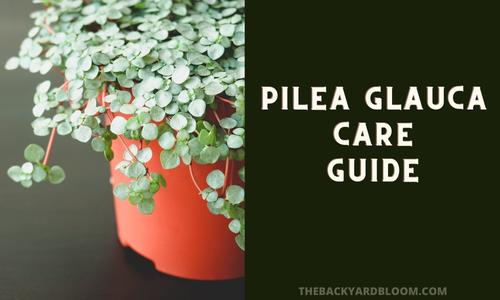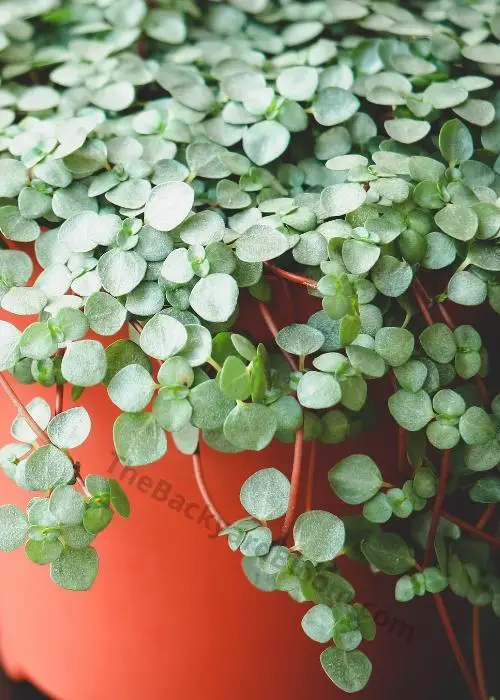Please note that this post may contain affiliate links. You can read my full affiliate disclosure at the bottom of the page.
The Pilea Glauca Mystifall (aka Pilea Aquamarine or Red Stemmed Pilea) is a trailing indoor houseplant with very small silvery green leaves and red stems. This coloring and petite leaves give it quite a unique look that can be great for many attractive plant displays. It is common for people to use these plants in terrariums due to their love of high humidity. If you have just recently picked up a Pilea Glauca Mystifall and want to know how to take care of it then this care guide is just for you.
Pilea Glauca Origin
The Pilea Glauca ‘Mystifall’ is native to Cuba.
Originally it appeared in publications of botany as early as 1866 under the name Pilea pendula Griseb and then again in1891 under the name Adicea pendula Kuntze. But later was published and accepted under the name Pilea libanensis.
Scientific Name: Pilea libanensis
Other Names
- Red Stem Pilea
- Red-stemmed Pilea
- Pilea Aquamarine
- Aquamarine Plant
- Silver Sparkle Pilea
- Grey Baby Tears
- Adicea Pendula Kuntze
- Pilea pendula Griseb.

Quick Overview Of How to Care For a Pilea Glauca ‘Mystifall’
- Water once the top inch of soil has dried out.
- Bright indirect light, avoid harsh direct sunlight.
- Use a mixture of 75% cactus/succulent soil mix with 25% perlite.
- Temperatures: 60°F – 80°F
- High humidity (60%-90%)
- Can be propagated via cuttings.
- Pet friendly: Not toxic to cats or dogs.
Other Pilea Care Guides:
Watering
Water the plant once the top few inches of soil has dried out. You can check the moisture of the soil by sticking your finger into the top layer up to the second knuckle. If it still feels moist when you do this then hold off on watering and check again in a few days.
Owners often find that they need to water these plants more frequently than other houseplants that they have. So try to avoid a schedule and just water the plant after you check the soil moisture and find it to be dry.
Do not overwater or let the plant sit in stagnant water or soggy soil. Overwatering can lead to issues with these plants.
You also want to avoid letting the plant stay dry for too long. Pilea Glaucas will start to drop leaves if they are underwater.
Light Requirements
Pilea Glaucas do best in bright indirect light. Morning sun or late afternoon sun is ok but avoid direct midday sunlight.
Avoid sitting the plant in a south-facing window unless you have it several feet back from the window. Many people who put their Glauca in a south window wind up with the side towards the window getting sunburn.
You can also use a grow light with Pilea Glaucas. Many people find that adding a grow light over their Pilea helps it grow better.
Pilea Glauca Soil
Use a cactus or succulent soil and mix it with perlite. 75% succulent soil and 25% perlite is a good ratio to use.
Having a good draining soil mixture that does not retain water is important to avoid the roots being in soggy soil. Without drainage in the soil root rot will set in.
Temperature
Optimal temperatures for Pilea Glauca plants is between 60°F and 80°F. Avoid letting the temperature drop below 55°F.
Don’t allow your Pilea to sit in a draft, the cold and dryness will quickly do in these plants.
Pilea Glauca Humidity
Pilea Glauca plants love high humidity, between 60% and 90% is optimal. People often use small humidifiers near the plant or use a glass cloche to help keep humidity levels high.
Misting a Pilea Glauca to help keep up is generally not a good idea. Misting plants can be troublesome as any lack of air circulation could quickly lead to bacteria rot on the leaves or stems. Instead of misting look for alternative ways to keep humidity levels high around your plant. Things such as small humidifiers, indoor glass greenhouses, a glass cloche, or a terrarium are much better options than misting the plant.
Fertilizer
Fertilize once a month with an organic liquid houseplant fertilizer such as Espoma Organic Indoor Plant Food.

Growth
The Pilea Glauca can grow rather fast. The exact rate of growth will depend on the environmental factors that an individual plant is in.
For the best growth make sure to give the plant plenty of bright indirect light, keep the humidity up, water when the top few inches of soil have dried, don’t allow it to go dry too long, and fertilize it once a month.
Potting
Using a shallow pot that is wide is a good idea for these plants. This way you can give a wide base for the roots to grow but also not allow much depth for moist soil to cause damage to the root system.
Also, make sure that the pot you choose has drainage holes. Drainage holes are very important to avoid root rot.
Pilea Glauca Propagation
You can propagate a Pilea Glauca using stem cuttings and putting the cuttings in a pot with damp potting soil. Cover the pot with a plastic bag and put it in a spot that gets bright light. Open the bag up every couple of days to allow air circulation and check the progress of your cuttings.
Toxicity
The Pilea Glauca, like other Pilea plants, is not toxic to cats or dogs. This is a great plant for a pet friendly household or office.
Common Problems and Pests
Dropping Leaves
A Pilea Glauca often will start to drop leaves if it has not been getting enough water. If this is the reason then you will notice them start to dry up and drop off.
But it can also drop leaves due to overwatering. Leaves dropping due to overwatering usually start out yellowing first, then falling off.
Burnt Leaves
If your Pilea Glauca is left in an area where it is getting direct sunlight during the midday hours then you will most likely see burnt leaves.
Root Rot
Pilea Glaucas are very prone to root rot. Avoid overwatering, have well draining soil, and a pot that allows for drainage and you should be able to avoid getting this.
If you do end up with root rot, it is very hard to get these plants to recover. Many people end up just taking cuttings from the plant and propagating a new plant. Luckily these are very easy to propagate with cuttings.
Where to Find a Pilea Glauca For Sale and Price Range
Pilea Glauca plants are a common plant to find in local plant shops as well as bigbox stores such as Lowes or Home Depot. Online sellers also have these plants on marketplaces such as Etsy.
Usually, these plants are under $10 for small pots.
References:
- Pilea libanensis; National Parks Flora & Fauna Web; https://www.nparks.gov.sg/florafaunaweb/flora/5/3/5392
- Pilea libanensis Urb.; Royal Botanic Gardens Kew; https://powo.science.kew.org/taxon/urn:lsid:ipni.org:names:196237-2
- Toxic and Non-Toxic Plant List – Cats; ASPCA.org; https://www.aspca.org/pet-care/animal-poison-control/cats-plant-list
- Toxic and Non-Toxic Plant List – Dogs; ASPCA.org; https://www.aspca.org/pet-care/animal-poison-control/dogs-plant-list